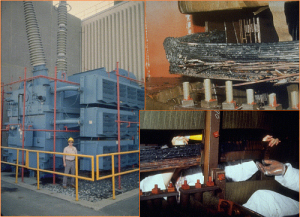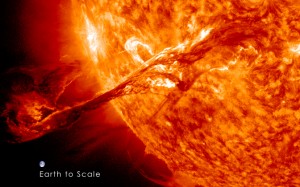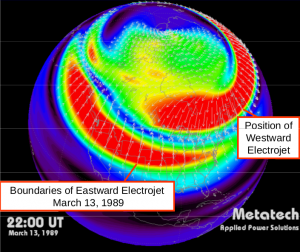
A stability map of a simple power grid. Each point on this image represents an operating state of a simple power grid consisting of a few generators. Bluish regions constitute stable working states, red unstable and ‘salt-and-pepper’ represent chaotic behavior. One can tune a grid for stability by controlling the phasing of generators and transformers on the grid and such settings suffice for day-to-day operations. It is difficult to decide where, or by how much, abnormalities such as geomagnetic storms might push a system into red, unstable regions, or, worse, salt-and-pepper regions where the system oscillates between states. It is easy to find cases on the map where chaotic regions lie very close to stable regions, indicating that the destabilizing push need not be large at all. James Thorp, Cornell University, published in IEEE Spectrum
People paid to worry about the North American power grid regard geomagnetic storms as “high impact, low-frequency” events, spawning the inevitable acronym: HILF. Low frequency, in that a geomagnetic storm as intense as May 1921, at 5,000 nano-Teslas/minute, or the 1859 Carrington Event, best guess: 7,500 nano-Teslas/minute, might not happen in our lifetimes, the lifetimes of our children, or even our grand children. If signature traces in Arctic ice core samples are correct, these are ‘500 year events.’ When it comes to deciding where to put that preventative maintenance dollar, storm-proofing Oklahoma elementary schools against EF 5 tornadoes seems a far more practical spend than the hardening of electrical grids against a half-theoretical event that might not even happen in 500 years.
What pulls planners up short is the high impact part: the utter god-awfulness of a power grid that crashes and which then can’t boot itself up. There is a self-referential dependency: fixing a dysfunctional power grid requires it to be functional, as key aspects of the manufacturing of transformers need electricity.
Nor can one expect the cavalry to ride in anytime soon, as the vast geographic reach of geomagnetic storms means that one strong enough to take down the North American grid may very likely take down Eurasian grids as well – entire hemispheres could wind up in the toilet, and we only have two hemispheres. That and the statistical variableness to it all: the Carrington 1859 and May 1921 storms, nominally two ‘500 year events’ were, in fact, separated by only sixty-two years.



